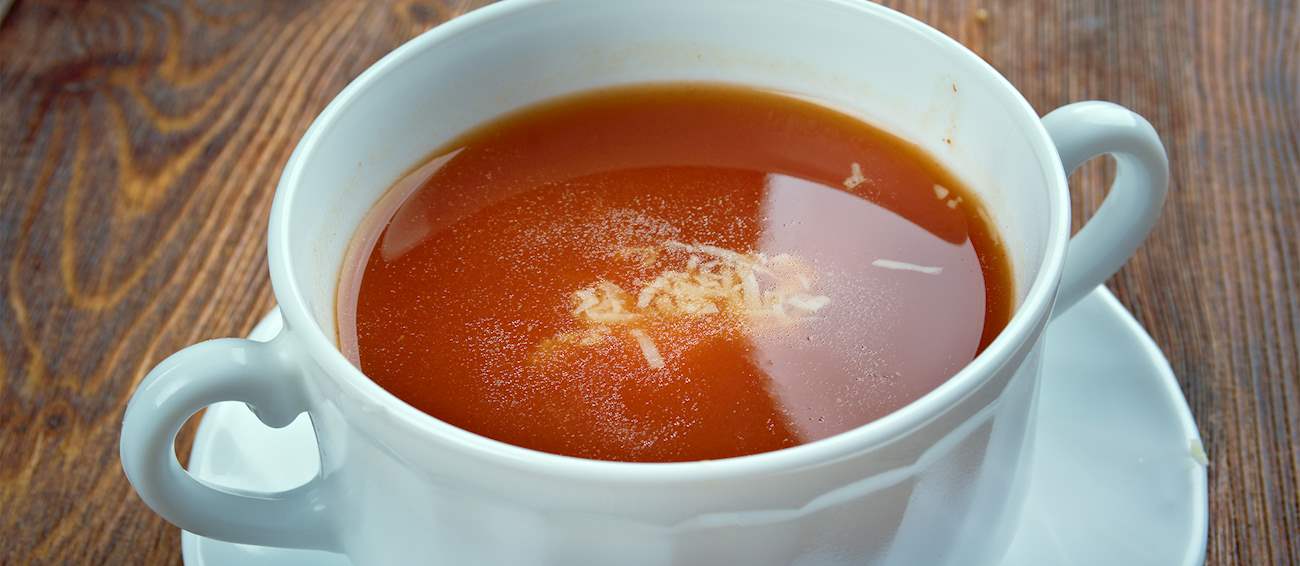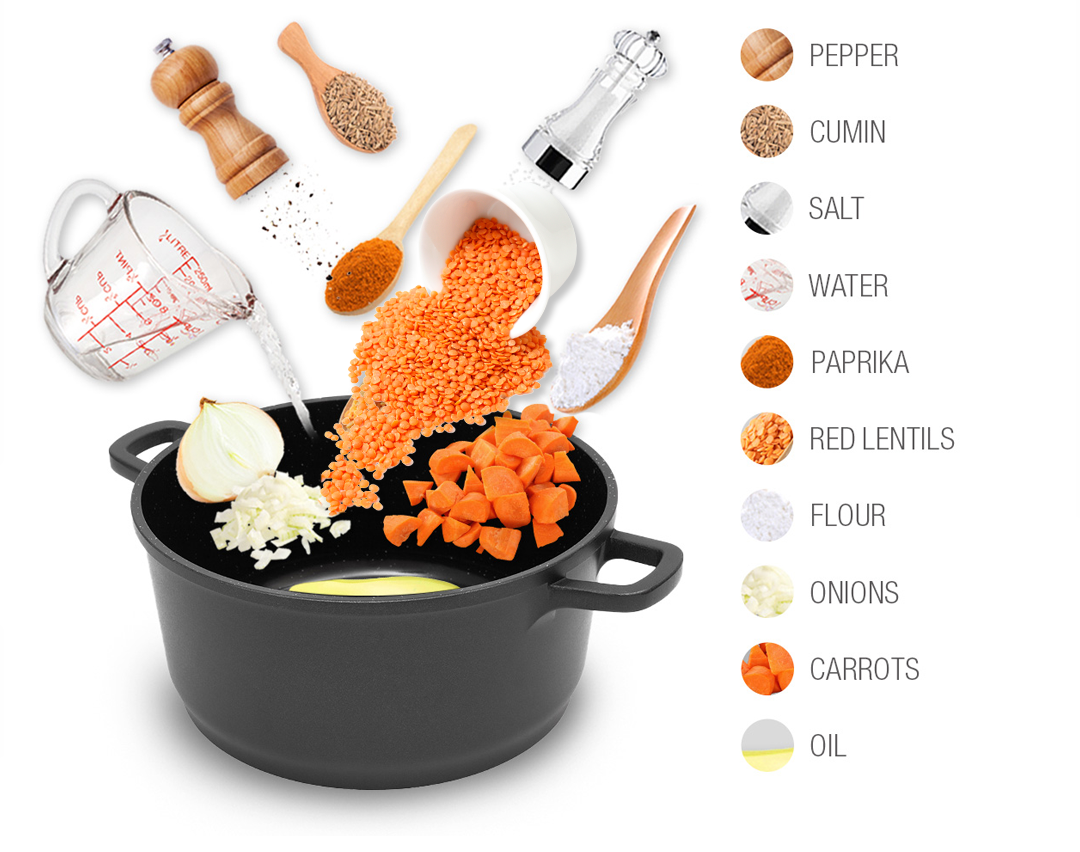MAIN INGREDIENTS
Mercimek çorbası is a beloved Turkish soup made with red lentils, chicken stock, onions, and carrots. It is often seasoned with salt, pepper, cumin, or paprika. Easy to prepare, filling, and warming, the soup is consumed for breakfast, lunch, or dinner in rural parts of Turkey, especially in local eateries known as lokantas.
MOST ICONIC Mercimek çorbası
View moreMAIN INGREDIENTS
Domates çorbası is a typical Turkish tomato soup featuring simple and fresh flavors. It consists of cooked or roasted tomatoes, onions, garlic, olive oil, flour, and water. The soup is often seasoned with salt and ground pepper, and it is traditionally garnished with a few fresh basil leaves.
This light meal is typically prepared during hot summer days, acting as a refreshment. It can be served either hot or cold.
MAIN INGREDIENTS
Sayur lodeh is a traditional dish made with vegetables stewed in coconut milk. Eggplant, jackfruit, melinjo, long beans, and carrots are the most common vegetables used in the dish. However, sayur lodeh is so versatile that any vegetable can be utilized.
The spices can also be adjusted, but sayur lodeh should always be generously seasoned and spiced. The origin of sayur lodeh is the Indonesian island of Java, and it is traditionally served on slametan - Javanese feasts celebrating certain special occasions.
MOST ICONIC Sayur lodeh
View moreMAIN INGREDIENTS
A great example of Turkish regional cuisine, Ezogelin çorbası is a hearty, mint-flavored soup made with red lentils, bulgur, pepper paste, and various Turkish spices. The origins of this classic Turkish winter dish are attributed to an unhappily married woman named Ezo who lived in the village of Dokuzyol near Gaziantep in the early 20th century.
It is believed that Ezo used to make this soul-warming soup in a desperate effort to win over her mother-in-law's cold heart. Ezo's story was often depicted in films and lamented in folksongs, and her name still lives on in this flavorful dish. Today, apart from being served as a warm starter or even as a breakfast meal, Ezogelin çorbası is traditionally prepared as soul food for the young brides-to-be in order to sustain them for the marital journey that lies ahead.
MOST ICONIC Ezogelin çorbası
View moreRasam is a South Indian soup made with a base of tamarind juice and added ingredients such as pepper, cumin, chili, lemon, lentils, and tomatoes, resulting in a tangy and sour flavor of the dish. The name of the dish can be literally translated to juice, referring to tomato or tamarind juices.
Originally, rasam was made only with tamarind and black pepper due to the abundance of those ingredients in South India. The soup is usually served as an appetizer with rice on the side. Traditionally, it is consumed after sambar, and followed by the main dish with curd rice.
VARIATIONS OF Rasam
MOST ICONIC Rasam
View moreMAIN INGREDIENTS
Sayur asem is a sweet and sour vegetable soup. Often referred to as tamarind soup, it is one of the favorite vegetable dishes in Indonesia. The entire dish is based on tamarind, an unusual plant commonly grown in Southeast Asia, which gives the dish a distinctive sour taste.
Other traditional Indonesian ingredients in sayur asem include jackfruit, melinjo, long beans, bilimbi, pumpkin, corn, and chayote. Sayur asem originated among the Sundanese people residing in West Java. However, their original recipe for this traditional soup has been adapted across Indonesia.
MOST ICONIC Sayur asem
View moreSoybean sprout soup is a hearty South Korean classic that is typically associated with Jeonju. Apart from the sprouts, the soup traditionally consists of a flavorful broth and rice, but the optional ingredients may include various vegetables or an egg, which is sometimes served on the side.
The soup is traditionally prepared and served in earthenware pots (ttukbaegi), and it can be topped with chili paste, scallions, or seaweed (kelp).
Dal adas is a traditional vegetarian dish hailing from the southern Iranian port city of Bushehr, located on the Persian Gulf. Reminiscent of an Indian dal, this dish typically consists of red lentils which are simmered in vegetable stock with sautéed onions and garlic, diced potatoes, tomato purée, and spices such as turmeric, cumin, cinnamon, chili powder, and salt.
The combination is enhanced with fresh lime juice or tamarind paste, and it can have a thin and soupy or thick and stew-like consistency. This spicy lentil soup or stew is generally served with freshly chopped coriander and red chili on top, and it's usually accompanied by Persian rice or warm bread on the side.
Ash-e jo is a hearty Iranian soup which combines barley and various beans and lentils. It appears in numerous varieties and can be complemented with various vegetables, spices, and fresh herbs. Even though meat is easily incorporated into the soup, it is not a traditional ingredient used in the preparation of ash-e jo.
The soup is characterized by its thick texture and a slightly sour taste provided by freshly squeezed lemon juice and barberries.
Kongnamul guk is a traditonal South Korean soup prepared with soybean sprouts as the main ingredient. This typical everyday soup has many variations and can be made with different broths (especially the anchovy-based one) or even water. Red chili flakes are often added for a kick of spiciness.
Other common ingredients for the soup include scallions and garlic. It's important not to overcook the sprouts, and if properly prepared, the soup should have a subtle nutty flavor and the sprouts should remain crunchy.
TasteAtlas food rankings are based on the ratings of the TasteAtlas audience, with a series of mechanisms that recognize real users and that ignore bot, nationalist or local patriotic ratings, and give additional value to the ratings of users that the system recognizes as knowledgeable. For the “Top 24 Asian Vegetable Soups” list until March 21, 2025, 1,571 ratings were recorded, of which 647 were recognized by the system as legitimate. TasteAtlas Rankings should not be seen as the final global conclusion about food. Their purpose is to promote excellent local foods, instill pride in traditional dishes, and arouse curiosity about dishes you haven’t tried.





























